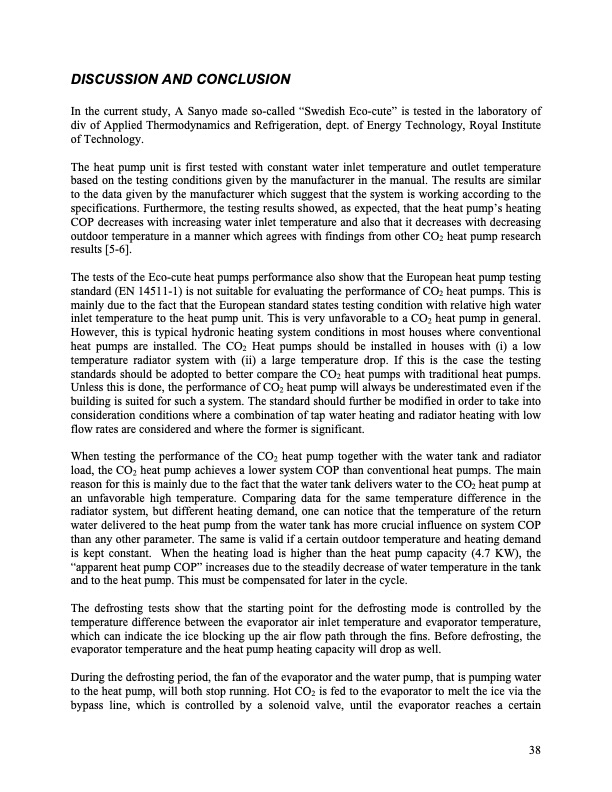
PDF Publication Title:
Text from PDF Page: 039
DISCUSSION AND CONCLUSION In the current study, A Sanyo made so-called “Swedish Eco-cute” is tested in the laboratory of div of Applied Thermodynamics and Refrigeration, dept. of Energy Technology, Royal Institute of Technology. The heat pump unit is first tested with constant water inlet temperature and outlet temperature based on the testing conditions given by the manufacturer in the manual. The results are similar to the data given by the manufacturer which suggest that the system is working according to the specifications. Furthermore, the testing results showed, as expected, that the heat pump’s heating COP decreases with increasing water inlet temperature and also that it decreases with decreasing outdoor temperature in a manner which agrees with findings from other CO2 heat pump research results [5-6]. The tests of the Eco-cute heat pumps performance also show that the European heat pump testing standard (EN 14511-1) is not suitable for evaluating the performance of CO2 heat pumps. This is mainly due to the fact that the European standard states testing condition with relative high water inlet temperature to the heat pump unit. This is very unfavorable to a CO2 heat pump in general. However, this is typical hydronic heating system conditions in most houses where conventional heat pumps are installed. The CO2 Heat pumps should be installed in houses with (i) a low temperature radiator system with (ii) a large temperature drop. If this is the case the testing standards should be adopted to better compare the CO2 heat pumps with traditional heat pumps. Unless this is done, the performance of CO2 heat pump will always be underestimated even if the building is suited for such a system. The standard should further be modified in order to take into consideration conditions where a combination of tap water heating and radiator heating with low flow rates are considered and where the former is significant. When testing the performance of the CO2 heat pump together with the water tank and radiator load, the CO2 heat pump achieves a lower system COP than conventional heat pumps. The main reason for this is mainly due to the fact that the water tank delivers water to the CO2 heat pump at an unfavorable high temperature. Comparing data for the same temperature difference in the radiator system, but different heating demand, one can notice that the temperature of the return water delivered to the heat pump from the water tank has more crucial influence on system COP than any other parameter. The same is valid if a certain outdoor temperature and heating demand is kept constant. When the heating load is higher than the heat pump capacity (4.7 KW), the “apparent heat pump COP” increases due to the steadily decrease of water temperature in the tank and to the heat pump. This must be compensated for later in the cycle. The defrosting tests show that the starting point for the defrosting mode is controlled by the temperature difference between the evaporator air inlet temperature and evaporator temperature, which can indicate the ice blocking up the air flow path through the fins. Before defrosting, the evaporator temperature and the heat pump heating capacity will drop as well. During the defrosting period, the fan of the evaporator and the water pump, that is pumping water to the heat pump, will both stop running. Hot CO2 is fed to the evaporator to melt the ice via the bypass line, which is controlled by a solenoid valve, until the evaporator reaches a certain 38PDF Image | CO2 heat pumps for the Swedish market

PDF Search Title:
CO2 heat pumps for the Swedish marketOriginal File Name Searched:
P3-slutrapport.pdfDIY PDF Search: Google It | Yahoo | Bing
CO2 Organic Rankine Cycle Experimenter Platform The supercritical CO2 phase change system is both a heat pump and organic rankine cycle which can be used for those purposes and as a supercritical extractor for advanced subcritical and supercritical extraction technology. Uses include producing nanoparticles, precious metal CO2 extraction, lithium battery recycling, and other applications... More Info
Heat Pumps CO2 ORC Heat Pump System Platform More Info
| CONTACT TEL: 608-238-6001 Email: greg@infinityturbine.com | RSS | AMP |